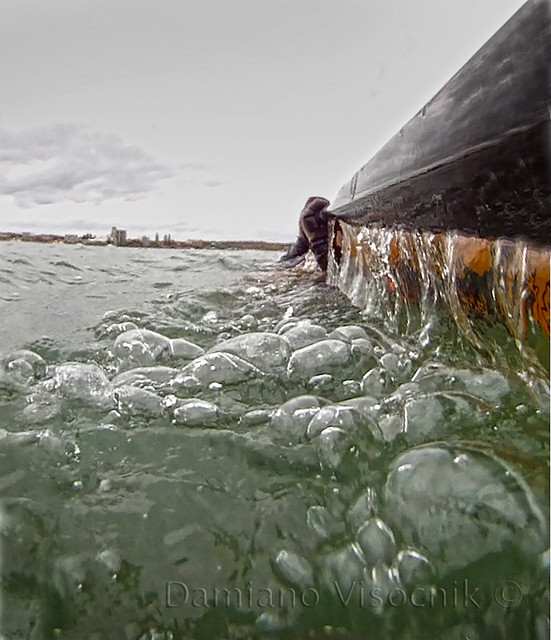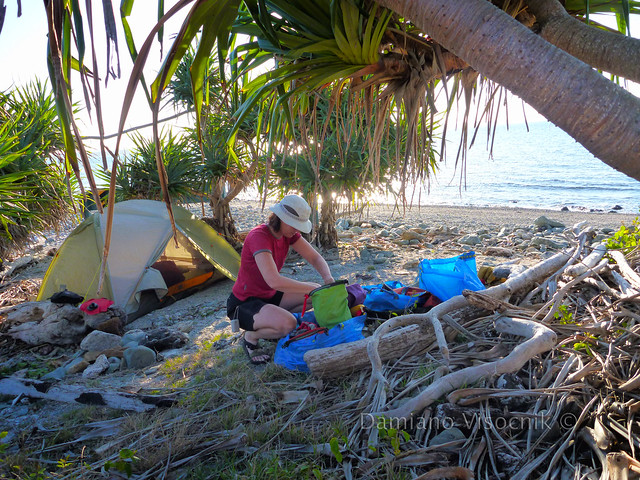I wanted to end the year 2010 with a bit of wet fun.
Despite the forecasted 20 knots wind I picked up my kayak and headed for a gentle break that promised some good runs.
The water was extremely dirty from all the recent flooding but the surf was still good.
This year has been exceptionally exciting for my sea kayaking and 2011 is promising to be even better.
31 December 2010
24 December 2010
Missing telemarking
Half of the Northern hemisphere is in the grip a real cold snap and snow is creating havoc from London to Paris to metropolis of North America.
On the other hand the early winter is bringing the coveted white Christmas to so many snow loving skiers.
Ski resorts are having mother nature provide the magical white blanket for the exceptional powder experience early in the season.
There was a time when I lived in US and A that skiing was a real passion of mine.
Longtime downhiller skier I grew bored with just ripping the slopes at reckless speed; I wanted to try something different: I converted to telemarking.
More difficult and more tiring then downhill I found telemarking initially way more challenging. To telemark I had to relearn how to ski: the weight distribution occurs on the exact opposite ski than alpine style. Once perfected I never returned to conventional skis.
A few rusty free-heel turns in the Australian Alps. MEI archives_Tess Dodd
It looks like there is a correlation between telemarking and Greenland paddles: both have ancient roots.
So why transition to tools that are harder to use?
Because just like Greenland paddling, to me telemarking is way more graceful than alpine skiing.
The focus is not on speed but on the fluid motion of the turns and graceful dance-like feeling when perfected; telemarking suits more my style.
On the other hand the early winter is bringing the coveted white Christmas to so many snow loving skiers.
Ski resorts are having mother nature provide the magical white blanket for the exceptional powder experience early in the season.
 |
| Mammoth Lakes, CA. File Image provided by MEI SoCal_Edgard Peralta |
There was a time when I lived in US and A that skiing was a real passion of mine.
Longtime downhiller skier I grew bored with just ripping the slopes at reckless speed; I wanted to try something different: I converted to telemarking.
More difficult and more tiring then downhill I found telemarking initially way more challenging. To telemark I had to relearn how to ski: the weight distribution occurs on the exact opposite ski than alpine style. Once perfected I never returned to conventional skis.
A few rusty free-heel turns in the Australian Alps. MEI archives_Tess Dodd
It looks like there is a correlation between telemarking and Greenland paddles: both have ancient roots.
So why transition to tools that are harder to use?
Because just like Greenland paddling, to me telemarking is way more graceful than alpine skiing.
The focus is not on speed but on the fluid motion of the turns and graceful dance-like feeling when perfected; telemarking suits more my style.
20 December 2010
Stick use spreading
Another “victim” of the “Stick Cult” Stevatron finds the Greenland paddle to his liking.
It appears that the stick is stirring emotions among some paddlers.
Initially ridiculed as not much good other than to show off with when rolling, a couple of sprint challenges with big Euro bladed local paddlers and a few surfing sessions have really put a damper on the laughter.
On the other side of the world the use of the traditional paddles has better acceptance.
Local interest in the stick is growing and after short trials followed up by persistence in learning the technique, more kayakers are now using the stick for most of their paddling.
But, as I've said before: it’s not for everybody and not ideally suited for racing. Just like different kayaks are best suited for a given purpose, the stick excels in recreational paddling.
Learning how to properly use a traditional paddle takes time. Initially I felt inadequate with a paddle that offered so little resistance in the water. I feared that it would not give me enough support for my high braces in the surf.
Stevatron with the Euro paddle
I also thought that I would lag behind when paddling in a group of kayakers with Euro paddles.
Those reservations seem to be common among the paddlers that borrow our traditional paddles for the first time.
Proficient rollers that have been using the explosive power of a CtoC roll suddenly find themselves failing and swimming when using the stick for the first time.
Just like paddling, rolling with the stick is “low impact” and requires a better technique.
Last Saturday two proficient kayakers new to the stick learned the finesse of sculling and rolling with a GP.
Greg Schwarz was again happy to coach the fine points for using the stick.
Summer is looking very busy sharing knowledge with people interested in trying the stick.
It appears that the stick is stirring emotions among some paddlers.
Initially ridiculed as not much good other than to show off with when rolling, a couple of sprint challenges with big Euro bladed local paddlers and a few surfing sessions have really put a damper on the laughter.
On the other side of the world the use of the traditional paddles has better acceptance.
Local interest in the stick is growing and after short trials followed up by persistence in learning the technique, more kayakers are now using the stick for most of their paddling.
But, as I've said before: it’s not for everybody and not ideally suited for racing. Just like different kayaks are best suited for a given purpose, the stick excels in recreational paddling.
Learning how to properly use a traditional paddle takes time. Initially I felt inadequate with a paddle that offered so little resistance in the water. I feared that it would not give me enough support for my high braces in the surf.

Stevatron with the Euro paddle
I also thought that I would lag behind when paddling in a group of kayakers with Euro paddles.
Those reservations seem to be common among the paddlers that borrow our traditional paddles for the first time.
Proficient rollers that have been using the explosive power of a CtoC roll suddenly find themselves failing and swimming when using the stick for the first time.
Just like paddling, rolling with the stick is “low impact” and requires a better technique.
Last Saturday two proficient kayakers new to the stick learned the finesse of sculling and rolling with a GP.
Greg Schwarz was again happy to coach the fine points for using the stick.
Summer is looking very busy sharing knowledge with people interested in trying the stick.
13 December 2010
On blogging
A recent post from Silbs made me reflect on the reasons I blog.
Since I don't have commercial reasons to advertise my products or ideas I wondered on my motives. It must be because I find that sharing knowledge enhances my life.
There is a tremendous amount of very good work out there, in cyberspace.
Just like I often come across great ideas, reports and good information in general when browsing for a particular item, I wish to share my findings with others. I have learned a lot from my fellow bloggers.
There are the usual high speed commercial sites where the info can be occasionally biased, there are a few good amateur independent offerings and then there are the useless ones that just like to post mindless material because they can.
And that last one seems to be the subject of Silbs post.
Does one really feel the need to post countless images of questionable quality of the same subject? surely they can see that a bit of culling would make the blog a bit more attractive.
The same goes with reports of trips and events.
Does anybody really care that I got up early in the morning to cook porridge and then pack up my camp and then load the kayak and then launch in a bit of North-Easterly and that the humidity was high and I was paddling at 5.3Kmp with a 45 degree feather in my paddle? You know what I mean.
I understand that not all blogs are directed towards a universal audience but even the selected few that might know the person/location could possibly get bored.
I am a lousy writer therefore I try to relay what I experienced with images. But just because an image says a thousand words it does not mean I should create "verbal diarrhea" by posting too many images of the same thing. The advent of digital photography means we can take hundreds of images but I select my images; only the ones I think are the very best make the cut and only very few are published. If any average photographer would pay just a bit more attention to on how they take the an image and try to be more selective when they publish or share them then I might better see the experience they are trying to relay to me.
The same goes with prose: cut the unnecessary stuff and tell me more about the essence and the experience, not the mundane facts.
Combine good images with decent copy and maybe there is something I can be bothered reading. Seakayakphoto is an outstanding example on how to create an appealing story: images and copy.
While I believe that no blogger is immune to ego, I notice some just like to post hoping to get attention.

Unfortunately some have very little to say and their efforts have the opposite effect, leaving them open to ridicule.
Some bloggers go for the "reheated news". Seen somewhere else an article that seems to be popular? Let's repost it in my blog hoping to generate some traffic.
I find it OK if a blogger actually comes across a terrific piece of work that is rather obscure and believes that it deserves a bit more publicity, but question the motive of those who cut/paste sensationalistic news so people flock to their blog.
I don't know what to say but I am compelled to have a new post? There is always the option of having unrelated professionals write for me. Maybe the topic has to be a bit generic but at least my blog has a new post.
I was recently approached by a commercial company of writers that does just that. They offered to write an article for Gnarlydog News for free to then have their company linked on my blog.
I asked them to write something about Aleut and Greenland paddles. Their reply:
"...However I feel that our writers may not be able to deal with a topic of that nature.
Have you anything else you would be interested in featuring on your website. Maybe something on travel kayaking? "
Yeah, a generic post about travelling: how riveting :-)
OK, not everybody can be good at blogging. I certainly am just average.
My writing is a bit ghetto but I like to use the excuse that English it's my 4th language. I try a bit harder with images though.
Some posts require a fair amount of planning, preparing and executing the footage/images.
Once I have acquired the material I spend some time editing it since I regard my raw footage as only good for a draft, rarely worthy of presentation.
I like to present my work with straight horizons and I crop out the disturbing elements, if I can. A bit of polishing makes a huge difference.
Despite all that I don't spend too much time capturing the footage, I'm rarely getting paid for it :-)
It's just an amateur effort in capturing fun moments of my activities, something that I will like to review in years to come.
Certainly bloggers are free to write what they want and publish as many pictures as they please, but if you want others to be as interested as you are in your offerings, it pays to remember: "quality over quantity".
Since I don't have commercial reasons to advertise my products or ideas I wondered on my motives. It must be because I find that sharing knowledge enhances my life.
There is a tremendous amount of very good work out there, in cyberspace.
Just like I often come across great ideas, reports and good information in general when browsing for a particular item, I wish to share my findings with others. I have learned a lot from my fellow bloggers.
There are the usual high speed commercial sites where the info can be occasionally biased, there are a few good amateur independent offerings and then there are the useless ones that just like to post mindless material because they can.
And that last one seems to be the subject of Silbs post.
Does one really feel the need to post countless images of questionable quality of the same subject? surely they can see that a bit of culling would make the blog a bit more attractive.
The same goes with reports of trips and events.
Does anybody really care that I got up early in the morning to cook porridge and then pack up my camp and then load the kayak and then launch in a bit of North-Easterly and that the humidity was high and I was paddling at 5.3Kmp with a 45 degree feather in my paddle? You know what I mean.
I understand that not all blogs are directed towards a universal audience but even the selected few that might know the person/location could possibly get bored.
I am a lousy writer therefore I try to relay what I experienced with images. But just because an image says a thousand words it does not mean I should create "verbal diarrhea" by posting too many images of the same thing. The advent of digital photography means we can take hundreds of images but I select my images; only the ones I think are the very best make the cut and only very few are published. If any average photographer would pay just a bit more attention to on how they take the an image and try to be more selective when they publish or share them then I might better see the experience they are trying to relay to me.
The same goes with prose: cut the unnecessary stuff and tell me more about the essence and the experience, not the mundane facts.
Combine good images with decent copy and maybe there is something I can be bothered reading. Seakayakphoto is an outstanding example on how to create an appealing story: images and copy.
While I believe that no blogger is immune to ego, I notice some just like to post hoping to get attention.

Unfortunately some have very little to say and their efforts have the opposite effect, leaving them open to ridicule.
Some bloggers go for the "reheated news". Seen somewhere else an article that seems to be popular? Let's repost it in my blog hoping to generate some traffic.
I find it OK if a blogger actually comes across a terrific piece of work that is rather obscure and believes that it deserves a bit more publicity, but question the motive of those who cut/paste sensationalistic news so people flock to their blog.
I don't know what to say but I am compelled to have a new post? There is always the option of having unrelated professionals write for me. Maybe the topic has to be a bit generic but at least my blog has a new post.
I was recently approached by a commercial company of writers that does just that. They offered to write an article for Gnarlydog News for free to then have their company linked on my blog.
I asked them to write something about Aleut and Greenland paddles. Their reply:
"...However I feel that our writers may not be able to deal with a topic of that nature.
Have you anything else you would be interested in featuring on your website. Maybe something on travel kayaking? "

Yeah, a generic post about travelling: how riveting :-)
OK, not everybody can be good at blogging. I certainly am just average.
My writing is a bit ghetto but I like to use the excuse that English it's my 4th language. I try a bit harder with images though.
Some posts require a fair amount of planning, preparing and executing the footage/images.
Once I have acquired the material I spend some time editing it since I regard my raw footage as only good for a draft, rarely worthy of presentation.
I like to present my work with straight horizons and I crop out the disturbing elements, if I can. A bit of polishing makes a huge difference.
Despite all that I don't spend too much time capturing the footage, I'm rarely getting paid for it :-)
It's just an amateur effort in capturing fun moments of my activities, something that I will like to review in years to come.
Certainly bloggers are free to write what they want and publish as many pictures as they please, but if you want others to be as interested as you are in your offerings, it pays to remember: "quality over quantity".
tags
blog,
feedback,
psychology,
publishing,
readers
06 December 2010
GEAR: the humble stick_Aleut and Greenland paddles

The last couple of years I have been paddling with sticks exclusively. Initially I had reservation about its performance in rough water but soon realized that that they are very capable even in the surf.
Recently a buddy of mine intrigued by my moves wanted to try the stick. Originally from New South Wales, he has been paddling for years in rough water and has undertaken long trips along the East coast of Australia. His surfing ability is remarkable. He saw no point to first pussy-foot around in calm waters; he wanted to see if the stick has credentials in the surf.
Surely it can’t be too good in conditions where power is everything, or is it?
I quickly lost sight of him: he paddled away into the thick of the big surf while I was holding back in the gentler waves (my surfing skills are basic). Then I saw him capsize and I was predicting a swim; after all he has been using the stick for little more than 10 minutes. Not so, he easily rolled up and powered down a face of a wave.
Later he commented that the Greenland paddle seemed to offer him less support in the surf but still performed when he needed it while not hindering any of his surfing. It was interesting to hear that from somebody that knew nothing about Greenland paddles. He had a split Euro style paddle on deck as back-up but never reached for it. He was hooked.
Back in the shelter of the lagoon we tried some traditional rolling and a bit of sculling. It became evident that his rolls were based on muscled efforts, something that I often see with paddlers that rely on the lifting power of a big blade.
photo published with permission by wolftone
I still remember one proficient kayaker that is very good at rolling with his wing blade not being able to roll with the Greenland paddle when trying it for the first time.
My eye is critical enough now to notice the same power technique used by most of the local paddlers when rolling with Euro paddles. All force, little finesse.
So why bother with finesse if a standard C-to-C roll gets you up anyway?
I used to think the same: once you know how to roll, why bother with “fancy” rolling.Warren Williamson seem to have some interesting thoughts on the ability to roll in many different ways.
Working on Greenland rolls or training rolls, will really help your rolling skills over all. I find it so amazing, I hear kayakers a lot of times say, in regards to Greenland rolls, "why would you ever need to do that roll."The way I see it, it's not that you would ever need to do that roll but what that roll can teach you.
If all you know how to do is let’s say a few standard rolls with the paddle, you really don't know just where you’re at with your technique.
Rolling with a paddle is just about the same as reaching up and grabbing onto a fixed object. You can literally come flying up out of the water because you have so much leverage with the paddle. You can get away with bad technique time after time and not know it.
Warren puts it into words way better than I could.
Since I have been playing around with traditional paddles my technique has improved. From being able to only do power rolls I am now able to execute a couple of different rolls and I have gained a higher understanding of the handling of the kayak. Slowly I have taken away pressure from my paddle and started to use my body more for turning a kayak back up.
What’s limiting me from learning advanced rolls is being rather inflexible and poorly coordinated. But every occasion I spend time just “playing” I progress my overall skills. I view it as cross training. Rolling helps me with finessing the boat when surfing.
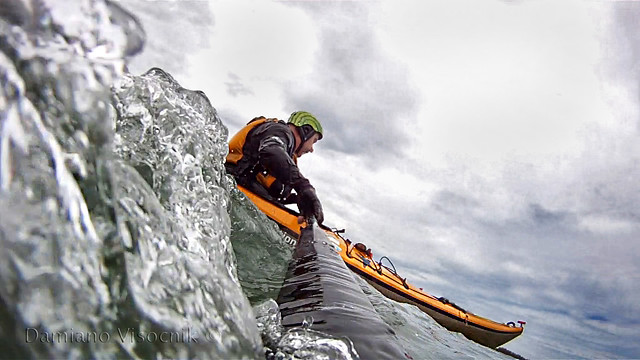
I have several traditional paddles. I use Aleut and Greenland paddles. I find the difference between the two subtle when used as a cruising paddle.
I think that the Aleut is easier to learn to use and appears to grab more water (it is slightly wider than my GPs). I also find that the Aleut does not require canting of the blade. On long paddles (expeditions) I find my Aleut to be easier to use when I am tired. It is however noisier than my Greenland paddles.
Initially I thought that a GP fluttered more in the water. It was Greg Schwarz that enlightened me on the need to subtly angle the blade when entering the water ('cant') to achieve minimal splash and prevent aeration behind the paddle.
Below is a quiver of Aluet and Greenland paddles. Click on image to enlarge.
1) Greenland, carbon balsa core
2) Aleut, solid WRC
3) storm size Greenland, carbon balsa core
4) norsak WRC
5) storm size Aleut, solid WRD
6) Aleut, solid WRC (back side showing)
7-8) Greenland, hollow core laminated WRC
9) Aleut, solid WRC
10) Aleut, bidirectional laminated solid
While the canting technique requires some time getting used to, it is essential for good Greenland paddling.
Where I find the GP excels is with rolling: it’s so incredibly effortless when slicing through the water in a sweep roll. Its shape offer immediate lift when sweeping and there is no need to pay attention to the precise set up usually required with a Euro paddle. The GP seems to orient itself.
As Dubside says all you need to do is: “relax and go wide”
The popularity of the traditional paddle is growing but it probably will never reach huge numbers. Most paddlers are not convinced that a humble wooden stick can really perform. I used to think that too.
And then there is the commercialization and advertising side.Very little money is spent by the industry to push a product that seems to be so low-tech. Good GPs are crafted, not manufactured.
Crafting a product requires skills and time, something that usually it’s hard to commercialize on a mass scale.
03 December 2010
29 November 2010
VIDEO: the little stick that could
select 360p if you have slow internet connection
The locals keep on telling me that my stick ain't no good for much else than show.
I should listen to them.
23 November 2010
GEAR: sleeping bag comparison
Extended outdoor pursuits often involve overnighting in locations away from accommodation.
I have been enjoying camping in remote locations for a few decades and most times I have provided my own shelter and bedding.
One item that I regard essential for good nights sleep is a suitable sleeping bag.
Second to some form of shelter (not always) the sleeping bag is probably the one item that can make my sleep enjoyable.
Even on very minimalistic trips I have never left it behind.
I have owned countless sleeping bag and currently I have 9 in my wardrobe.
Incidentally all of those sleeping bags are down filled.
I don't own a single synthetic one.
Why?... a couple of reasons.

3 packed-up bags: synthetic (warm-ish), synthetic (cold-ish) and down (warm). Coke can for sizing
When I first started camping (motorcycle days) I was given a synthetic sleeping bag as a present.
Having never owned one before, I was stoked.
It kept me warm at night and that was it.
So why don't I have one now?
My new synthetic sleeping bag was admittedly a bit bulky and used to take up a lot of room on the back saddle of the motorcycle.
With time it became much easier to compress it in the factory storage bag provided.
I thought I was getting good at compressing it but also noticed that it no longer kept me warm on cold night.
My once greatly lofting sleeping bag was now sagging and became thin, all in the short time of about a year.
Eventually I gave up twisting throttles and enjoyed backpacking (bushwalking) more.
My synthetic sleeping bag engulfed half of the space available inside my enormous backpack.
After a couple of outings with experienced bushwalkers I soon realized that synthetic sleeping bags just are not compact nor warm; the other guys all had down filled sleeping bags.
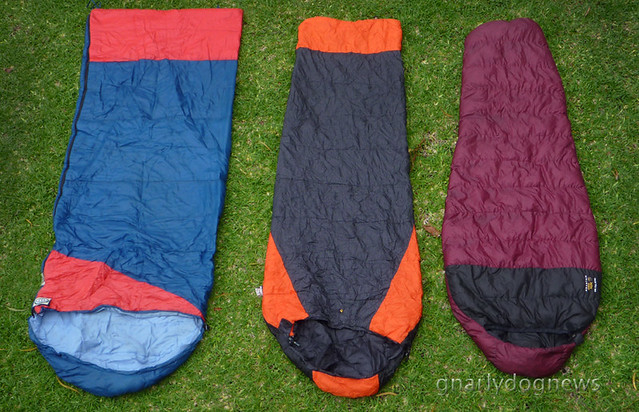
same sleeping bags as in previous photo: out of their compression bag
A down sleeping bag was my next purchase.
I then discovered the other great benefits of a down sleeping bag.
For the same temperature rating my down sleeping bag also weighted half as much.
Much more compact an much lighter: I really liked that.
I also realized that a down sleeping bag had a wider comfort temperature range meaning that it was not too hot during mild nights and still warm enough when the temperature dropped.
It's the natural ability of the tiny down plumes to regulate the comfort level of the sleeper.
Being a natural product down breathes better and will let body moisture escape through the fill better than synthetic.
My down sleeping bags don't suffer from loft loss like my synthetic bag did.
I have one bag that's probably 17 years old and I still use it for the same conditions as when it was new.
If not abused down will really last a long time.
In this comparison I have depicted 3 sleeping bags: two synthetic ones (borrowed) and one down one.
The maroon/black colored one is the down one.
Incidentally is also the warmest.
If size matters (or lack thereof) the photographs speak for themselves.
Just like with my sleeping mats: less is more.

While there is no significant size difference between the bagged (compressed) synthetic bag in the black sack and the down in the orange one, now notice below the two bags out of the compression sack.
The synthetic one offers very little insulation resulting in a comfortable sleep only during warm nights.
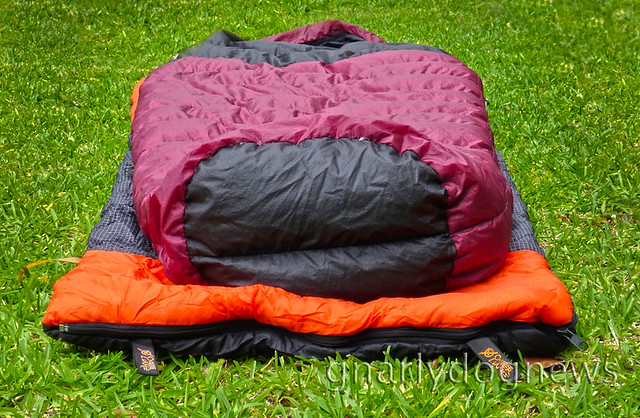
The synthetic bags are also much wider in the feet area.
Some might think that a bit roomy is good in balmy conditions, it becomes cold comfort when the sleeping bag should keep you warm.
Despite what technical claims will try to sell you, a sleeping bag is efficient when it traps the body heat provided by the occupant.
And to date there is no better practical insulator than non circulating air.
By lofting down creates a chamber where the air does not move. The thicker this chamber is the warmer the bag.
Furthermore the sleeping bag should prevent the escape of the warm air created by your body.
A wide hood will be unable to trap this warm air and a sleeping bag without a hood is only suitable for mild temperatures.
In essence, to be warm, a sleeping bag should have:
-decent thickness (loft)
-a fitted hood (preferably 3 dimensional)
- a narrow foot area
There are many other additional features that will make a bag even better, but should not lack the above ones.
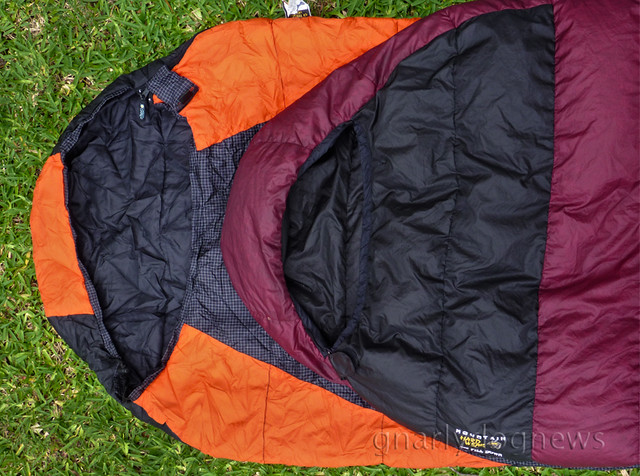
My pictorial comparison is however biased.
The down sleeping bag is a high end one with 800 loft down, close cut, body contoured.
The synthetic ones are entry level offerings from discount stores.
The price difference is substantial but considering that a well looked after down bag will really last you for years, it probably evens out.
There are better synthetic sleeping bags out there but, in my experience, none come close to the performance of down.
The argument that a wet synthetic sleeping bag will keep you warmer than a down one doesn't fly with me.
I wish to never have to sleep in a wet bag, down or synthetic.
All sleeping bags should be protected in a dry bag where getting it wet should not be an issue.
In twenty five years of camping I am yet to experience a shelter leaking enough to really wet my bag and warrant the use of a synthetic one.
Sure, there are some extreme cases where maybe a synthetic bag would be a better choice; It just does not happen around my part of the woods or stretch of coast :-)
Last but not least: cheap, good... pick one.
Down sleeping bags vary a lot in price. It is worth doing a bit of homework before heading to your favorite retailer. There is a lot of good info/reviews available on line; try to avoid the ones that are commissioned by one manufacturer :-)
I have been enjoying camping in remote locations for a few decades and most times I have provided my own shelter and bedding.
One item that I regard essential for good nights sleep is a suitable sleeping bag.
Second to some form of shelter (not always) the sleeping bag is probably the one item that can make my sleep enjoyable.
Even on very minimalistic trips I have never left it behind.
I have owned countless sleeping bag and currently I have 9 in my wardrobe.
Incidentally all of those sleeping bags are down filled.
I don't own a single synthetic one.
Why?... a couple of reasons.

3 packed-up bags: synthetic (warm-ish), synthetic (cold-ish) and down (warm). Coke can for sizing
When I first started camping (motorcycle days) I was given a synthetic sleeping bag as a present.
Having never owned one before, I was stoked.
It kept me warm at night and that was it.
So why don't I have one now?
My new synthetic sleeping bag was admittedly a bit bulky and used to take up a lot of room on the back saddle of the motorcycle.
With time it became much easier to compress it in the factory storage bag provided.
I thought I was getting good at compressing it but also noticed that it no longer kept me warm on cold night.
My once greatly lofting sleeping bag was now sagging and became thin, all in the short time of about a year.
Eventually I gave up twisting throttles and enjoyed backpacking (bushwalking) more.
My synthetic sleeping bag engulfed half of the space available inside my enormous backpack.
After a couple of outings with experienced bushwalkers I soon realized that synthetic sleeping bags just are not compact nor warm; the other guys all had down filled sleeping bags.

same sleeping bags as in previous photo: out of their compression bag
A down sleeping bag was my next purchase.
I then discovered the other great benefits of a down sleeping bag.
For the same temperature rating my down sleeping bag also weighted half as much.
Much more compact an much lighter: I really liked that.
I also realized that a down sleeping bag had a wider comfort temperature range meaning that it was not too hot during mild nights and still warm enough when the temperature dropped.
It's the natural ability of the tiny down plumes to regulate the comfort level of the sleeper.
Being a natural product down breathes better and will let body moisture escape through the fill better than synthetic.
My down sleeping bags don't suffer from loft loss like my synthetic bag did.
I have one bag that's probably 17 years old and I still use it for the same conditions as when it was new.
If not abused down will really last a long time.
In this comparison I have depicted 3 sleeping bags: two synthetic ones (borrowed) and one down one.
The maroon/black colored one is the down one.
Incidentally is also the warmest.
If size matters (or lack thereof) the photographs speak for themselves.
Just like with my sleeping mats: less is more.

While there is no significant size difference between the bagged (compressed) synthetic bag in the black sack and the down in the orange one, now notice below the two bags out of the compression sack.
The synthetic one offers very little insulation resulting in a comfortable sleep only during warm nights.

The synthetic bags are also much wider in the feet area.
Some might think that a bit roomy is good in balmy conditions, it becomes cold comfort when the sleeping bag should keep you warm.
Despite what technical claims will try to sell you, a sleeping bag is efficient when it traps the body heat provided by the occupant.
And to date there is no better practical insulator than non circulating air.
By lofting down creates a chamber where the air does not move. The thicker this chamber is the warmer the bag.
Furthermore the sleeping bag should prevent the escape of the warm air created by your body.
A wide hood will be unable to trap this warm air and a sleeping bag without a hood is only suitable for mild temperatures.
In essence, to be warm, a sleeping bag should have:
-decent thickness (loft)
-a fitted hood (preferably 3 dimensional)
- a narrow foot area
There are many other additional features that will make a bag even better, but should not lack the above ones.

My pictorial comparison is however biased.
The down sleeping bag is a high end one with 800 loft down, close cut, body contoured.
The synthetic ones are entry level offerings from discount stores.
The price difference is substantial but considering that a well looked after down bag will really last you for years, it probably evens out.
There are better synthetic sleeping bags out there but, in my experience, none come close to the performance of down.
The argument that a wet synthetic sleeping bag will keep you warmer than a down one doesn't fly with me.
I wish to never have to sleep in a wet bag, down or synthetic.
All sleeping bags should be protected in a dry bag where getting it wet should not be an issue.
In twenty five years of camping I am yet to experience a shelter leaking enough to really wet my bag and warrant the use of a synthetic one.
Sure, there are some extreme cases where maybe a synthetic bag would be a better choice; It just does not happen around my part of the woods or stretch of coast :-)
Last but not least: cheap, good... pick one.
Down sleeping bags vary a lot in price. It is worth doing a bit of homework before heading to your favorite retailer. There is a lot of good info/reviews available on line; try to avoid the ones that are commissioned by one manufacturer :-)
tags
backpacking,
camping,
lightweight,
review,
sleeping bag
18 November 2010
Comparison: Tahe Marine Greenland T vs Sea Spirit
Only in recent years has Australia started to see an influx of imported kayaks.
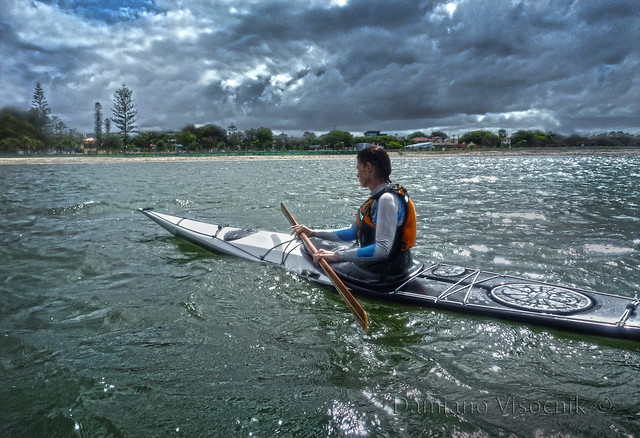
Most paddlers are content learning to roll as a mean to self rescue in an accidental capsize. My circle of friends of dedicated kayakers view rolling more than just a practical skill; they like rolling for the sake of rolling.
Once we learned the basic roll to right ourselves back up we started to explore the possibility of different rolls.
For the last couple of years I have observed a growing trend towards a more graceful paddling style where control of the boat is performed by edging of the hull instead of just pressing on the rudder pedals.
The ultimate kayak for this type of paddling is a Greenland style kayak.
Typically recognized by a low profile with a low rear deck and hard chined hull.
Importer Craig McSween of Adventure Outlet now has 3 different kayaks in stock that follow this design philosophy, all from Tahe Marine.
Already familiar with the performance of the Tahe Greenland, I was interested in trying out the larger siblings: the Tahe Greenland T and the Sea Spirit.
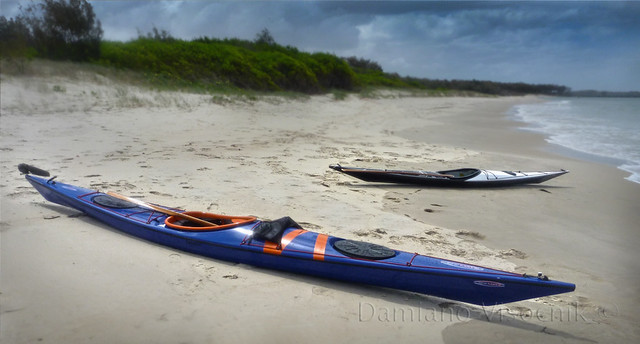
Craig was generous to allow us to test paddle them one afternoon in the relatively sheltered water of the Gold Coast Broadwater.
Conditions were mild: wind gusts of max 15 knots with little or no waves with a max of 1 knot of current.
The Greenland T is regarded as true Greenland form while I think that the Sea Spirit is more an all round kayak of Greenland style.
The T is a bit larger than the classic Greenland, a bit beamier and a slightly higher deck: unfortunately still too small for my large thighs and big feet.
Vanilla fitted the T well and Adventuretess found it roomy enough for possible all day paddles with a bit of wiggle room.
(Vanilla’s personal kayak is an Impex Force5 and Tess’ preferred kayak is her Nordkapp LV).
The T and Sea Spirit have a keyhole cockpit making entry/exit a bit easier than the traditional “ocean style” cockpit on the Tahe Greenland.
We had no means for scientifically measure max speeds of these kayaks but I don’t think they are designed as sprinting vessels.
Having a shorter waterline they accelerated easily and to maintain a cruising speed of 6-7km/h required little effort. The kayaks will start to hit the “hull speed wall” sooner than a long kayak.
However, because of their reduced wetter surface they will be easier to paddle, at club paddling pace, than a longer kayak.
The finish and the attention to detail on Tahe kayaks are superb. The external seam is a narrow black Kevlar tape that has a clear textured finish. Extremely neat.
There were no visible print through areas in the gel coat. The inside of the cockpit is finished with flow coat to prevent any possible fiberglass rash where the body contacts the deck.
The hatch covers (Kajak Sport lids), while very easy to secure/remove, maintained a dry interior during our prolonged rolling session.
select 360p to view vidoe if you don't have a fast internet connection
I believe that Tahe kayaks are a very good value for money alternative to the well established brands offered locally.
They might not be the ultimate bombproof expedition hulls of some British kayaks but they weigh and cost substantially less.
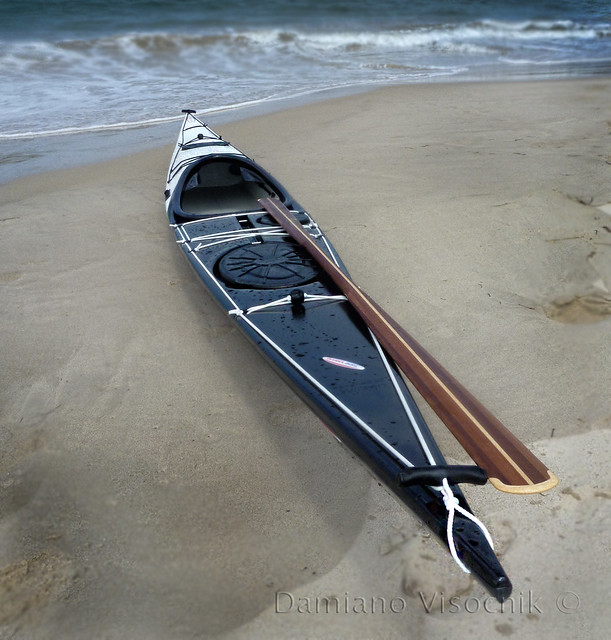
A novice might find the T a bit on the “tippy” side while the wider hull Sea Spirit will instill more confidence, in a beginner.
The T was fitted with a skeg and the Sea Spirit had a rudder (skeg also available).
In beam winds the T weather cocked minimally (a bit of edging was necessary if no skeg deployed). The Sea Spirit displayed no tendency of turning into the wind. Tess didn’t use the rudder (a spring loaded over-stern design that retracts onto the deck when not deployed) while Vanilla used it.

I did not like the rather diminutive back band on the T: maybe it was not adjusted well but kept on sneaking too low on my butt. It would be a real challenge to find a back band that would be supportive enough but still out of the way when lying back over the low rear deck.
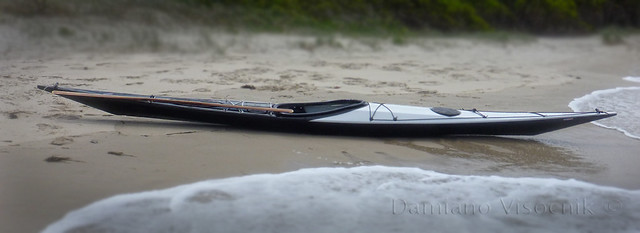
Greenland style kayaks have a hard chined hull that allow for fast maneuvering. Edging drastically changes the footprint of the submerged hull resulting in sharper handling than a round hull.
As expected both kayaks were outstanding rollers, compared to a higher rear decked one.
Both Vanilla and Tess (not expert rollers) could perform moves that are challenging in their own kayaks.
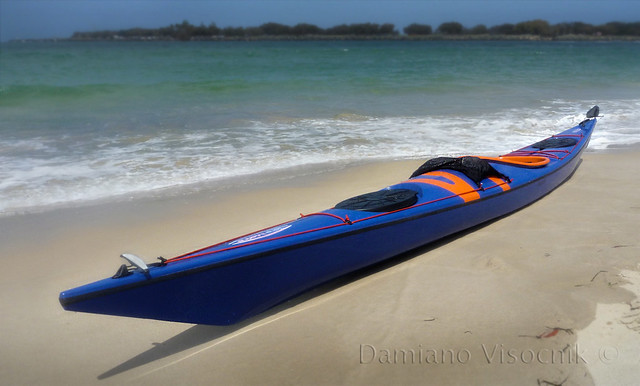
I believe the Sea Spirit would also be an ideal kayak for the beginner aspiring to become a proficient paddler seeking control of the boat.
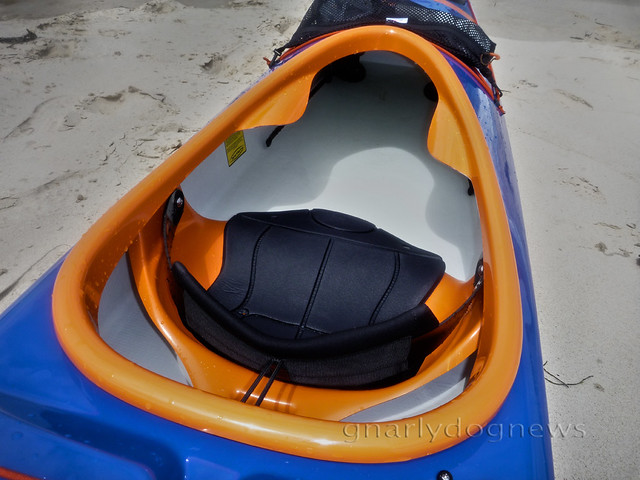
The seats in these kayaks are hung (bolted) from the deck and supported on the hull with a positive fastener that prevents them from swinging and potentially fail due to stress on the hanger (something that has happened on several kayaks of mine).
I found the Sea Spirit’s thigh braces too low and my legs would not fit comfortably under the deck. Unfortunately that is the case with the majority of performance kayaks: my legs are larger than average.
Adventuretess thought that the thigh braces were great. Vanilla would like to see them just a bit higher (or possibly modified by cutting away a small section of fiberglass).
Tahe offers solid foot pegs that are really easy to adjust, even while seated in the cockpit.
Swapping foot reach between Vanilla and Tess was a breeze: no need to undo any bolts or force a stubborn footpegs into the new position. On long paddles, if needed, one can simply reach below deck, twist a little shaft and reposition the pegs in a different location.
The Sea Spirit had only two hatches and lacked the typical day hatch behind the cockpit. Instead it had a nice low profile mesh bag in front of the cockpit.
I like Tahe’s philosophy on this one: to be able to offer a budget kayak (current retail of under $2600) they reduced the features instead of the quality.
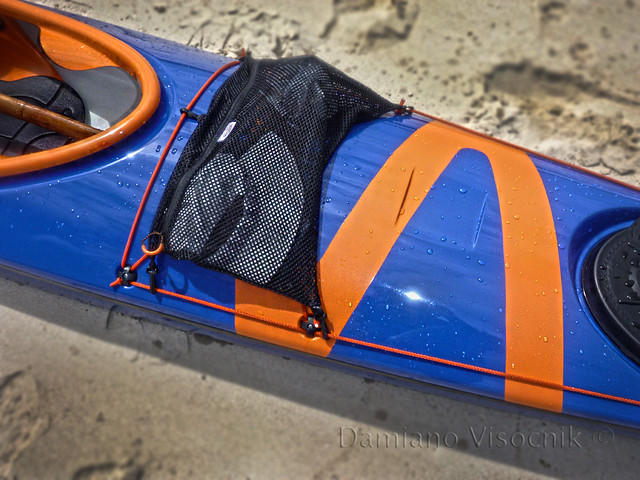
So far I have only had the opportunity to trial just a few of the kayaks from the extensive range available at Adventure Outlet.
Maybe one day I might even try one of the ruddered kayaks :-)

In the past, they were the domain of keen individuals that went through the hassle and expense of shipping them personally.
Most local retailers would offer kayaks that were mainly designed for paddling long distances and/or were rudder dependent.
Honestly, there really was not much choice for somebody desiring a performance close-fitting boat.
Available kayaks had huge hulls, high decks and most times an ill fitting cockpit.
I used to envy paddlers in North America and Great Britain: they had a huge choice available to them.
A few years ago skegged boats started to gain popularity here and only very recently some paddlers desired kayaks that are body fitting.
While the majority of paddlers are seeking a kayak that gets them on the water and allows them to explore the sheltered shores, some kayakers are discovering the fun that rolling brings.
Yes, you read it right: rolling can be fun.

Most paddlers are content learning to roll as a mean to self rescue in an accidental capsize. My circle of friends of dedicated kayakers view rolling more than just a practical skill; they like rolling for the sake of rolling.
Once we learned the basic roll to right ourselves back up we started to explore the possibility of different rolls.
Introduced to traditional paddles, we were no longer satisfied with just a forced marginal “all paddle” powered roll; we sought variety.
It’s hard to explain to a non roller what it feels like to be confident underwater and enjoy the feeling of being immersed upside down to then gently rotate your body and rise to the surface with grace.
A lot of our rolls require a lay back position onto the rear deck of the kayak that lowers the centre of gravity.
Unfortunately not many kayaks are designed with a lower rear deck.
Most kayaks are bulky and offer maximum cargo space often sacrificing maneuverability.For the last couple of years I have observed a growing trend towards a more graceful paddling style where control of the boat is performed by edging of the hull instead of just pressing on the rudder pedals.
The ultimate kayak for this type of paddling is a Greenland style kayak.
Typically recognized by a low profile with a low rear deck and hard chined hull.
Importer Craig McSween of Adventure Outlet now has 3 different kayaks in stock that follow this design philosophy, all from Tahe Marine.
Already familiar with the performance of the Tahe Greenland, I was interested in trying out the larger siblings: the Tahe Greenland T and the Sea Spirit.

Craig was generous to allow us to test paddle them one afternoon in the relatively sheltered water of the Gold Coast Broadwater.
Conditions were mild: wind gusts of max 15 knots with little or no waves with a max of 1 knot of current.
The Greenland T is regarded as true Greenland form while I think that the Sea Spirit is more an all round kayak of Greenland style.
The T is a bit larger than the classic Greenland, a bit beamier and a slightly higher deck: unfortunately still too small for my large thighs and big feet.
Vanilla fitted the T well and Adventuretess found it roomy enough for possible all day paddles with a bit of wiggle room.
(Vanilla’s personal kayak is an Impex Force5 and Tess’ preferred kayak is her Nordkapp LV).
The T and Sea Spirit have a keyhole cockpit making entry/exit a bit easier than the traditional “ocean style” cockpit on the Tahe Greenland.
We had no means for scientifically measure max speeds of these kayaks but I don’t think they are designed as sprinting vessels.
Having a shorter waterline they accelerated easily and to maintain a cruising speed of 6-7km/h required little effort. The kayaks will start to hit the “hull speed wall” sooner than a long kayak.
However, because of their reduced wetter surface they will be easier to paddle, at club paddling pace, than a longer kayak.
The finish and the attention to detail on Tahe kayaks are superb. The external seam is a narrow black Kevlar tape that has a clear textured finish. Extremely neat.
There were no visible print through areas in the gel coat. The inside of the cockpit is finished with flow coat to prevent any possible fiberglass rash where the body contacts the deck.
The hatch covers (Kajak Sport lids), while very easy to secure/remove, maintained a dry interior during our prolonged rolling session.
select 360p to view vidoe if you don't have a fast internet connection
I believe that Tahe kayaks are a very good value for money alternative to the well established brands offered locally.
They might not be the ultimate bombproof expedition hulls of some British kayaks but they weigh and cost substantially less.

A novice might find the T a bit on the “tippy” side while the wider hull Sea Spirit will instill more confidence, in a beginner.
The T was fitted with a skeg and the Sea Spirit had a rudder (skeg also available).
In beam winds the T weather cocked minimally (a bit of edging was necessary if no skeg deployed). The Sea Spirit displayed no tendency of turning into the wind. Tess didn’t use the rudder (a spring loaded over-stern design that retracts onto the deck when not deployed) while Vanilla used it.

I did not like the rather diminutive back band on the T: maybe it was not adjusted well but kept on sneaking too low on my butt. It would be a real challenge to find a back band that would be supportive enough but still out of the way when lying back over the low rear deck.

Greenland style kayaks have a hard chined hull that allow for fast maneuvering. Edging drastically changes the footprint of the submerged hull resulting in sharper handling than a round hull.
Hard chines promote and “engaged” paddling style where the kayaker uses his/her body to direct the kayak instead of relying on the rudder.
Both kayaks are fitted with integrated thigh braces allowing a good contact with the body for a positive retention when rolling.
I see the Sea Spirit as a very good learning kayak that still rewards an intermediate paddler that is interested in advanced techniques.As expected both kayaks were outstanding rollers, compared to a higher rear decked one.
Both Vanilla and Tess (not expert rollers) could perform moves that are challenging in their own kayaks.

I believe the Sea Spirit would also be an ideal kayak for the beginner aspiring to become a proficient paddler seeking control of the boat.

The seats in these kayaks are hung (bolted) from the deck and supported on the hull with a positive fastener that prevents them from swinging and potentially fail due to stress on the hanger (something that has happened on several kayaks of mine).
I found the Sea Spirit’s thigh braces too low and my legs would not fit comfortably under the deck. Unfortunately that is the case with the majority of performance kayaks: my legs are larger than average.
Adventuretess thought that the thigh braces were great. Vanilla would like to see them just a bit higher (or possibly modified by cutting away a small section of fiberglass).
Tahe offers solid foot pegs that are really easy to adjust, even while seated in the cockpit.
Swapping foot reach between Vanilla and Tess was a breeze: no need to undo any bolts or force a stubborn footpegs into the new position. On long paddles, if needed, one can simply reach below deck, twist a little shaft and reposition the pegs in a different location.
The Sea Spirit had only two hatches and lacked the typical day hatch behind the cockpit. Instead it had a nice low profile mesh bag in front of the cockpit.
I like Tahe’s philosophy on this one: to be able to offer a budget kayak (current retail of under $2600) they reduced the features instead of the quality.

So far I have only had the opportunity to trial just a few of the kayaks from the extensive range available at Adventure Outlet.
Maybe one day I might even try one of the ruddered kayaks :-)

08 November 2010
Technique: Vegemite roll
Kayak rolling can be a very serious matter.
Competition rolling has very strict rules and events are held around the world to crown the rolling champions.
Our little group of dedicated kayakers is lucky to have a highly skilled mentor who selflessly offers us his help to improve our skills even if we might never get to compete.
He practices yoga daily to keep his body supple and trains rolling several times a week.
Every time I meet up with him he shows me a new way to roll his kayak.
Most of his rolls are internationally recognised official Greenland style rolls used in competitions.
Lately he has been working on a roll all of his own that would make Australians proud: the Vegemite roll.
This roll complements the growing repertoir of Australian rolls that now inlcude the Magnum and the Thong roll.
Competition rolling has very strict rules and events are held around the world to crown the rolling champions.
Our little group of dedicated kayakers is lucky to have a highly skilled mentor who selflessly offers us his help to improve our skills even if we might never get to compete.
He practices yoga daily to keep his body supple and trains rolling several times a week.
Every time I meet up with him he shows me a new way to roll his kayak.
Most of his rolls are internationally recognised official Greenland style rolls used in competitions.
Lately he has been working on a roll all of his own that would make Australians proud: the Vegemite roll.
This roll complements the growing repertoir of Australian rolls that now inlcude the Magnum and the Thong roll.
05 November 2010
GEAR: PLB versus SPOT
A few years ago I purchased a PLB for sea kayaking.
No good having that emergency beacon below deck then...
While my PLB is small and light enough to not be felt when paddling I have not been totally satisfied by its reliability.
.jpg)
One can pre-write a message that can be sent out to his/her contacts (email or mobile txt message) and alert them of your wish.
.jpg)
Is SPOT the perfect tool?
Not really.
I would like to see the ability to send out more than just pre-recorded messages.
I hope that in the future SPOT will offer a unit that might do that.
Or maybe there will be an "emergency beacon" app for the iPhone :-)
It was the new GPS enabled unit that pin points its position more accurately for easier location by the emergency crews.
While I would technically (and legally) be better served by a proper EPIRB, the PLB size makes it a safer unit for sea kayaking, in my opinion.
I can wear mine attached to the shoulder of my life jacket (aka as PFD... dang there are a lot of acronyms in this write up :-).
An EPIRB would probably be stowed below deck when out at sea in my kayak where a possible emergency situation could see me getting separated from my vessel.No good having that emergency beacon below deck then...
While my PLB is small and light enough to not be felt when paddling I have not been totally satisfied by its reliability.
I hear of way too many units failing due to water intrusion (see this post).
The initial purchase cost is also a bit on the steep side for some paddlers.
How much does your life cost?_ is a typical question but one has a hard time coughing up that kind of money on a safety unit that most likely (and hopefully) will never be used.
That made me think of the alternative: the SPOT.
While SPOT can still be used as an emergency beacon (some argue that is not as effective: longer response time) the little unit offers more features that would make the purchase more "justified".
SPOT has the ability to send out a signal for emergency as well as one that just asks for help, but not rescue.
.jpg)
One can pre-write a message that can be sent out to his/her contacts (email or mobile txt message) and alert them of your wish.
Any message: "need more food" , "come and get me, I'm chucking in the sponge", "" "all is good, I just hit a snag"... you name it.
SPOT also can send out your location position to your contacts.
It can be sent out as a Google Earth placement and your "support crew" can determine your whereabouts.
And that's a great feature, in my opinion.
I wish I had a SPOT when on a trip where I could not communicate via cell phone (too remote, no coverage) to my land crew on the estimated meeting time for the arrival pick up.
Sure, a satellite phone would have solved that but that gadget is even more expensive than the PLB.
SPOT uses less power than a satellite phone too: no need for recharging.
Initially costsing considerably less than a PLB, SPOT requires an annual subscription to the service.
After 4 years of SPOT use (including unit purchase), the costs equals to the one of an inexpensive PLB.
I can't comment on reliability, yet.
SPOT also can send out your location position to your contacts.
It can be sent out as a Google Earth placement and your "support crew" can determine your whereabouts.
And that's a great feature, in my opinion.
I wish I had a SPOT when on a trip where I could not communicate via cell phone (too remote, no coverage) to my land crew on the estimated meeting time for the arrival pick up.
Sure, a satellite phone would have solved that but that gadget is even more expensive than the PLB.
SPOT uses less power than a satellite phone too: no need for recharging.
Initially costsing considerably less than a PLB, SPOT requires an annual subscription to the service.
After 4 years of SPOT use (including unit purchase), the costs equals to the one of an inexpensive PLB.
I can't comment on reliability, yet.
.jpg)
Is SPOT the perfect tool?
Not really.
I would like to see the ability to send out more than just pre-recorded messages.
I hope that in the future SPOT will offer a unit that might do that.
Or maybe there will be an "emergency beacon" app for the iPhone :-)
25 October 2010
TEST: Zegul 520 LV
I had the opportunity to do a brief test paddle of a brand new kayak: the Zegul 520 LV (by Tahe Marine).
The local importer had several new (to Australia) sea kayaks available for testing but the Zegul 520 definitely caught my eye over the 530 and the 550 models aimed towards the "need for speed" crowd.
Its profile resembles a more traditional kayak (so called Greenland lines) with a healthy overhanging bow.
With possibly a more pronounced upturned ends than the typical skin on frame kayak that I have seen, the hull appeared to have a considerable rocker in its keel.
The bow and stern are not as fine as the Tahe Greenland (also on offer at the demo) as there is more volume in those areas.
Actually the whole kayak is more "chunky" than the super-sleek looking Greenland.
With its generously long keyhole cockpit I could seat "bum first, legs later", even with my rather long legs.
The coaming slopes aggressively from high up front to pretty low on the back (I had no chance to get those measurements...).
Compared to the Greenland T, the front was substantially higher and the rear probably an inch higher.
Looking at the profile of the cockpit it had good credentials to be a "comfortable" low rear-deck kayak.
My quick compression test (the good old fashioned: press with my hand on the deck and hull) revealed that this kayak's lay-up had a bit more substance than the alarmingly soft deck of some other "glitter finish" British offerings :-)
The hull is a very solid carbon/Kevlar weave that is vacuum infused .
The finish is superb, inside and out.
The rear deck has a very clever profile that despite looking flat gives the surface an very positive support for possible over the deck reentry (not that you would on such a narrow high end kayak) and did not flex when I sat on it.
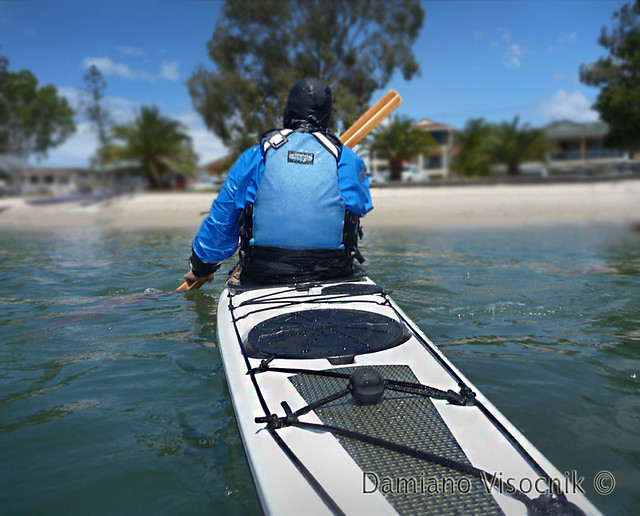
Initially I was sceptical about the third hatch in front of the cockpit: my experience with another British boat with that design was not positive.
But, on the Zegul, it proved to be out of the way of my knees and just big enough to store small items (compact camera, snack, towrope etc.)
The seat was a bit on the narrow side (may I say that my ass ain't size 30....).
I didn't like the configuration of the backband anchor point inboard, on the seat pan.
I would move it to the exterior of the pan and have a smooth surface with no plastic protruding into my hips.
The Zegul 520 trialled was an LV (low volume) version.
My thighs were just getting pinched at the start of the thigh braces.
I think I would fit the HV version better.
Kudos to Zegul (Tahe) for identifying that one size does not fit all body types and having two deck versions of the same hull.
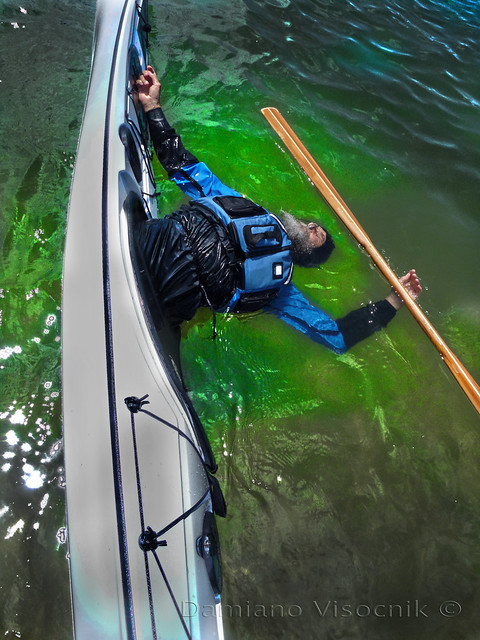
Greg balance bracing Zegul 520 LV
How did it behave on the water?
Better than expected.
Where you expecting it to behave bad?
Well, not really, but hopping in a new boat that is considerably narrower than my current kayaks, I was expecting the initial stability to be a bit more tender.
Interestingly enough Vanilla found the Zegul not as stable as I did.
Admittedly I thought it was a bit more tippy than the Tahe Greenland but I still felt confident to let go of the paddle and relax.
It will be interesting to see how the Zegul behaves in textured waters.
The low deck allowed me to lay on the back of the deck (with PFD) without lifting my bum out of the seat: great.
Finally a kayak that fits my legs and allows lay-backs.
The Zegul appeared to track straight (short test paddle with very little wind) and could be turned relatively sharp with a gentle sweep stroke and edging. The hard chined hull allows for precise maneuvering and correction of direction by dropping and edge, something that my round hulled kayak does not.
I felt a solid secondary stability and could drop the seam of the deck lower into the water than usual, without going over.
The Zegul shined when rolled: really.
With my limited rolling skills I could perform very slow Greenland layback rolls, something that I can't do too well in my high decked kayaks.
Skulling was a breeze, to the point of falling into a static brace with little effort.
The cockpit is roomy enough to allow my body to twist and my legs to move and apply pressure onto the deck to rotate the hull.
When I asked Greg Schwarz to briefly test the Zegul I just watched in awe the beautiful moves he could perform.
Then again Greg looks good in just about any kayak.
select 360p (not 720p) if you have slow internet connection
The Zegul 520 is a strong contender in my search for that elusive "Greenland style" kayak that would fit my non slender figure.
The quality of construction is impeccable and with the considerable lower price than the British competitors Tahe has brought to the masses a fantastic line-up of new kayaks.
PS FEB2011: I have added a Zegul 520 HV to my fleet and after a few paddles I have modified the cockpit set up. Details of the new seating arrangement coming soon...
The local importer had several new (to Australia) sea kayaks available for testing but the Zegul 520 definitely caught my eye over the 530 and the 550 models aimed towards the "need for speed" crowd.
Its profile resembles a more traditional kayak (so called Greenland lines) with a healthy overhanging bow.
With possibly a more pronounced upturned ends than the typical skin on frame kayak that I have seen, the hull appeared to have a considerable rocker in its keel.
The bow and stern are not as fine as the Tahe Greenland (also on offer at the demo) as there is more volume in those areas.
Actually the whole kayak is more "chunky" than the super-sleek looking Greenland.
With its generously long keyhole cockpit I could seat "bum first, legs later", even with my rather long legs.
The coaming slopes aggressively from high up front to pretty low on the back (I had no chance to get those measurements...).
Compared to the Greenland T, the front was substantially higher and the rear probably an inch higher.
Looking at the profile of the cockpit it had good credentials to be a "comfortable" low rear-deck kayak.
My quick compression test (the good old fashioned: press with my hand on the deck and hull) revealed that this kayak's lay-up had a bit more substance than the alarmingly soft deck of some other "glitter finish" British offerings :-)
The hull is a very solid carbon/Kevlar weave that is vacuum infused .
The finish is superb, inside and out.
The rear deck has a very clever profile that despite looking flat gives the surface an very positive support for possible over the deck reentry (not that you would on such a narrow high end kayak) and did not flex when I sat on it.

Initially I was sceptical about the third hatch in front of the cockpit: my experience with another British boat with that design was not positive.
But, on the Zegul, it proved to be out of the way of my knees and just big enough to store small items (compact camera, snack, towrope etc.)
The seat was a bit on the narrow side (may I say that my ass ain't size 30....).
I didn't like the configuration of the backband anchor point inboard, on the seat pan.
I would move it to the exterior of the pan and have a smooth surface with no plastic protruding into my hips.
The Zegul 520 trialled was an LV (low volume) version.
My thighs were just getting pinched at the start of the thigh braces.
I think I would fit the HV version better.
Kudos to Zegul (Tahe) for identifying that one size does not fit all body types and having two deck versions of the same hull.

Greg balance bracing Zegul 520 LV
How did it behave on the water?
Better than expected.
Where you expecting it to behave bad?
Well, not really, but hopping in a new boat that is considerably narrower than my current kayaks, I was expecting the initial stability to be a bit more tender.
Interestingly enough Vanilla found the Zegul not as stable as I did.
Admittedly I thought it was a bit more tippy than the Tahe Greenland but I still felt confident to let go of the paddle and relax.
It will be interesting to see how the Zegul behaves in textured waters.
The low deck allowed me to lay on the back of the deck (with PFD) without lifting my bum out of the seat: great.
Finally a kayak that fits my legs and allows lay-backs.
The Zegul appeared to track straight (short test paddle with very little wind) and could be turned relatively sharp with a gentle sweep stroke and edging. The hard chined hull allows for precise maneuvering and correction of direction by dropping and edge, something that my round hulled kayak does not.
I felt a solid secondary stability and could drop the seam of the deck lower into the water than usual, without going over.
The Zegul shined when rolled: really.
With my limited rolling skills I could perform very slow Greenland layback rolls, something that I can't do too well in my high decked kayaks.
Skulling was a breeze, to the point of falling into a static brace with little effort.
The cockpit is roomy enough to allow my body to twist and my legs to move and apply pressure onto the deck to rotate the hull.
When I asked Greg Schwarz to briefly test the Zegul I just watched in awe the beautiful moves he could perform.
Then again Greg looks good in just about any kayak.
select 360p (not 720p) if you have slow internet connection
The Zegul 520 is a strong contender in my search for that elusive "Greenland style" kayak that would fit my non slender figure.
The quality of construction is impeccable and with the considerable lower price than the British competitors Tahe has brought to the masses a fantastic line-up of new kayaks.
PS FEB2011: I have added a Zegul 520 HV to my fleet and after a few paddles I have modified the cockpit set up. Details of the new seating arrangement coming soon...
04 October 2010
Gear: the humble IKEA bag
Seen around the globe (or at least where Ikea is present) the humble blue Ikea bag is the ultimate gear schlepping tote.
While some use the blue bag as the ultimate fashion accessory , I have not found a better, simpler, sturdier, lighter and cheaper soft container to carry my kayaking stuff from the landing spot to the campsite.
On overnighters my kayak is usually light enough that two persons can easily just grab the kayak by the bow and stern and move it above the high tide mark and close to camp.
On longer trips the kayak tends to be loaded heavier.
Often it is necessary to unload at least some of the gear before moving the boat to the overnighting location.
The blue Ikea bag (named Frakta, in the Ikea catalogue) is just the ticket.
It is the last item I pack in my kayak before securing the hatch cover and the first one to come out and be filled with gear.
It certainly is sturdy enough to carry just about any load that one person is comfortable to lift.
The fabric is the universal "blue tarp" that is water resistant enough to be laid down on moist ground.
The handles/straps are solidly sewn onto the fabric to prevent a premature blow-out (unlike the handles of the stripy "refugee" bags).
I have noticed those blue bags in many pictures from kayakers all over the world, from innocent overnighters to famous expeditions to remote parts of the globe.
Image supplied by Douglas Wilcox, SeakayakPhoto
Image supplied by Douglas Wilcox, SeakayakPhoto
And last but not least, this great piece of equipment is by far the cheapest item of my kit: a whole $ 1.99
tags
accessory,
camping,
expedition,
sea kayak,
storage,
travel light
20 September 2010
Copyright infringment, again
Recently I have come across the blog of Canadian Ckayaker. 
In one of his posts I recognized one of my images.

Unable to find an authorization/bill of sale in my records for that image I contacted the owner of that blog, Michael Bradley of Hatley (Quebec), to find out where he sourced my image.
Michael's reply to me was vague and he could not "recall" the source of the image.
That particular image is displayed on my flickr account.
Michael has conveniently cropped my name and copyright watermark from the bottom of the image, just as somebody else did in a previous case
Further perusal of Ckayaker's blog reveals that Michael seems to be using a lot of images that don't look to be his and I tend to doubt that he has permission to use them.
It puzzles me that somebody who is a teacher, and is happy to have an article of his published by Sea Kayaker magazine, appears to be ignorant of copyright laws.
Maybe Michael thinks that "because it on the net" it's OK to appropriate and in his case modify the image to prevent identifying the rightful owner.
The comment "if you don't want to have your images pinched, don't put them on the net" typically comes from provincially minded individuals that often are jealous of other's achievements.
Those individuals are unable to produce photographic work that is worth pinching.
If a photographer is happy to share his/her work with others usually their images are licensed under the Creative Commons license.
Those images are often free of copyright as long as they are attributed and are not used for commercial applications.
So, next time you want to use somebody else image, contact the owner.
The law only allows the use of images without permission in very specific instances.
-
PS this post marks a milestone: according to webmetrics, Gnarlydog News has passed the 100.000 hits mark
tags
blog,
copyright infringment,
sea kayak
15 September 2010
Life Cycle_ a different view
In my previous life (that's before sea kayaking :-) I use to ride, a lot.
Living in Los Angeles I had access to one of the best riding terrain: the San Gabriel Mountains.
My passion was riding steep and rocky technical single-track trails.
old footage of a ride on one of my visits back to LA
Just as I now I own several kayaks, then I owned many mountain bikes.
I needed to ride regularly to escape from the oppressive urban environment I lived in.
That was then.
I still long for the all-day long rides I used to do with the A-Team (Adventure Team).
The riding terrain around my current locale is not as demanding nor as extensive as back in the old US and A.
I don't ride anymore.
Recently I came across this trailer for a bike movie.
Memories came flooding back...
Living in Los Angeles I had access to one of the best riding terrain: the San Gabriel Mountains.
My passion was riding steep and rocky technical single-track trails.
old footage of a ride on one of my visits back to LA
Just as I now I own several kayaks, then I owned many mountain bikes.
I needed to ride regularly to escape from the oppressive urban environment I lived in.
That was then.
I still long for the all-day long rides I used to do with the A-Team (Adventure Team).
The riding terrain around my current locale is not as demanding nor as extensive as back in the old US and A.
I don't ride anymore.
Recently I came across this trailer for a bike movie.
Memories came flooding back...
tags
extreme riding,
mountain bike
14 September 2010
Bilge pump system for sea kayaks_patent pending?
In late 2007 I published my installation for a sea kayak electric bilge pump (on QSKC website_ it has been recently removed by the current webmaster).
I published a variation of that installation on this blog in 2009.
The article has attracted a tremendous amount of interest and I have seen links to my article appear on many websites around the world.
USA, British and German readers are particularly interested in the set up.
Recently I have found a manufacturer that appears to offer the same set up commercially.

There are no details (images or drawings) of the system but it lists the components that are the same as my documented items.
The video on their website seems to replicate the identical set up as mine.
However what intrigued me is the mention of a magnetic switch for the activation of the pump (Bluewater website: "Sealed switch, waterproof, dustproof, operated by a sliding magnet that runs on your deck bunge cord")
To my knowledge, I was the first to publish the idea of the switch, even though it is not my invention.
I am not aware of any other publication showing the magnetic switch assembly.
I do know that manufacturers occasionally scan my blog for ideas and some actually use my findings on their products.
There is nothing wrong with that, or I would keep my tinkering ideas to myself.
What makes me a bit dubious is the fact that Bluewater claims a pending patent to the system.
Bluewater makes no mention of the alleged patent number (most manufacturer don’t divulge that) but I have not been able to find any documentation of such patent in my searches.
There are a couple of scenarios: Bluewater could have applied for a patent that is not directly related to the bilge pump system that I have documented or they are just bluffing to scare competition away.
Bluewater has not replied to my queries of patent application date, and probably won’t :-)
If Bluewater has applied for a patent of the existing system, it will not be valid.
The electric bilge pump system has been used for some time now (documented on several websites) and the magnetic switch documentation is not recent (Feb 2008)
Gnarlydog News ideas are published for the benefit of the private public and not for the monopolization from the industry.
I want to keep sharing my findings with fellow adventurers that might benefit from my projects.
I published a variation of that installation on this blog in 2009.
The article has attracted a tremendous amount of interest and I have seen links to my article appear on many websites around the world.
USA, British and German readers are particularly interested in the set up.
Recently I have found a manufacturer that appears to offer the same set up commercially.

There are no details (images or drawings) of the system but it lists the components that are the same as my documented items.
The video on their website seems to replicate the identical set up as mine.
However what intrigued me is the mention of a magnetic switch for the activation of the pump (Bluewater website: "Sealed switch, waterproof, dustproof, operated by a sliding magnet that runs on your deck bunge cord")
To my knowledge, I was the first to publish the idea of the switch, even though it is not my invention.
I am not aware of any other publication showing the magnetic switch assembly.
I do know that manufacturers occasionally scan my blog for ideas and some actually use my findings on their products.
There is nothing wrong with that, or I would keep my tinkering ideas to myself.
What makes me a bit dubious is the fact that Bluewater claims a pending patent to the system.
Bluewater makes no mention of the alleged patent number (most manufacturer don’t divulge that) but I have not been able to find any documentation of such patent in my searches.
There are a couple of scenarios: Bluewater could have applied for a patent that is not directly related to the bilge pump system that I have documented or they are just bluffing to scare competition away.
Bluewater has not replied to my queries of patent application date, and probably won’t :-)
If Bluewater has applied for a patent of the existing system, it will not be valid.
The electric bilge pump system has been used for some time now (documented on several websites) and the magnetic switch documentation is not recent (Feb 2008)
Gnarlydog News ideas are published for the benefit of the private public and not for the monopolization from the industry.
I want to keep sharing my findings with fellow adventurers that might benefit from my projects.
tags
bilge pump,
designs,
DIY,
electric bilge pump,
invention,
sea kayak
10 September 2010
REVIEW: Flat Earth Sails_a year later
It has been a year since I first tried Flat Earth Sails from Mick McRobb (review here)
The sail he sent me was a bit short for my kayak deck and the existing mounting location did not lend itself for perfect stowing on deck.
I however mounted that sail on Adventuretess' kayaks since they are shorter than mine.
She immediately liked the new sail.
I kept on using the old one that I designed (inspired by Sea Mongrel's rig).
For some reason Adveturetess seemed to always be that little bit faster than me but I assumed her boat had a better prismatic coefficient than mine...
Recently Mick sponsored me again with a new sail.
This time the sail was a bit bigger and the boom a bit longer.
I can now stow the folded sail neatly on deck (an important detail to me when I have to paddle into the wind in large seas).
After a two week trip where I was able to sail most of the time I have to report that Mick's sails rock, to put it mildly.
select 360p if you don't have fast Internet connection
His sails are superior to the old one I have used for years.
He designs a bit more twist in his high aspect sails.
Suddenly I was able to use a much wider wind "window".
I was surprised to be able to propel my kayak in winds that were just 30 degrees off the bow of my kayak.
Flat Earth Sails catch the wind better and make sailing possible where before I would stow my sail away on deck.
The shorter boom (compared to my old sail) allows full range of paddle strokes without the risk of hitting the end of the boom in a higher stroke style.
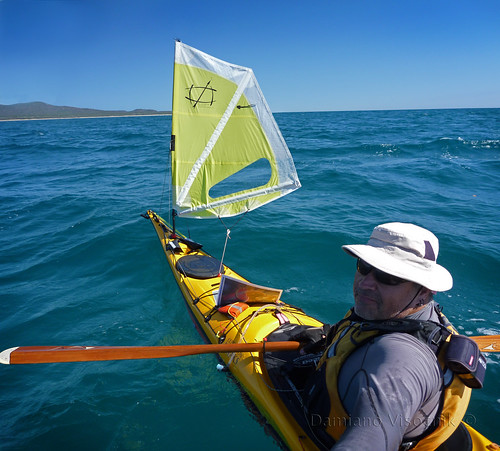
I just need to stretch myself a bit more when stowing the sail on deck while securing it with bungee and olive cleat.
As usual, Mick's work is really good.
His use of high tech/low stretch fabric for the perimeter of the sail makes the shape billow and be more efficient.
His slightly flexible boom (fibreglass sailing batten) is more forgiving in high wind gusts spilling a bit of force and preventing capsize.
I confidently sailed in beam seas where waves were washing over the deck.
I could run with the wind (wind from behind) and surf on quartering stern breezes.
On the new sail the connection of boom/mast is improved.
Mick now uses a full sleeve where the batten is inserted and then bolted to the pivoting mast fitting.
I find however that the top of the sail fabric (mast pocket) is a bit on the light side and abrasion could wear a hole prematurely. I reinforced the area with self adhesive sailing cloth (used for making numbers on sail).

old sail (left) and new one (on right)
While Mick has stock of a few different sizes of sails, he is happy to create a custom size or color for you.
The sail he sent me was a bit short for my kayak deck and the existing mounting location did not lend itself for perfect stowing on deck.
I however mounted that sail on Adventuretess' kayaks since they are shorter than mine.
She immediately liked the new sail.
I kept on using the old one that I designed (inspired by Sea Mongrel's rig).
For some reason Adveturetess seemed to always be that little bit faster than me but I assumed her boat had a better prismatic coefficient than mine...
Recently Mick sponsored me again with a new sail.
This time the sail was a bit bigger and the boom a bit longer.
I can now stow the folded sail neatly on deck (an important detail to me when I have to paddle into the wind in large seas).
After a two week trip where I was able to sail most of the time I have to report that Mick's sails rock, to put it mildly.
select 360p if you don't have fast Internet connection
His sails are superior to the old one I have used for years.
He designs a bit more twist in his high aspect sails.
Suddenly I was able to use a much wider wind "window".
I was surprised to be able to propel my kayak in winds that were just 30 degrees off the bow of my kayak.
Flat Earth Sails catch the wind better and make sailing possible where before I would stow my sail away on deck.
The shorter boom (compared to my old sail) allows full range of paddle strokes without the risk of hitting the end of the boom in a higher stroke style.

I just need to stretch myself a bit more when stowing the sail on deck while securing it with bungee and olive cleat.
As usual, Mick's work is really good.
His use of high tech/low stretch fabric for the perimeter of the sail makes the shape billow and be more efficient.
His slightly flexible boom (fibreglass sailing batten) is more forgiving in high wind gusts spilling a bit of force and preventing capsize.
I confidently sailed in beam seas where waves were washing over the deck.
I could run with the wind (wind from behind) and surf on quartering stern breezes.
On the new sail the connection of boom/mast is improved.
Mick now uses a full sleeve where the batten is inserted and then bolted to the pivoting mast fitting.
I find however that the top of the sail fabric (mast pocket) is a bit on the light side and abrasion could wear a hole prematurely. I reinforced the area with self adhesive sailing cloth (used for making numbers on sail).

old sail (left) and new one (on right)
While Mick has stock of a few different sizes of sails, he is happy to create a custom size or color for you.
17 August 2010
PLB problem and modification
I have been using a Personal Locator Beacon for a few years.

While Australian Maritime laws require that I should carry an EPIRB while paddling offshore (more than two nautical miles from shore in non sheltered waters) I find that for sea kayaking a PLB is possibly a safer unit to have in case of emergency.
I believe that a beacon should be carried on the person and be readily accessible in case of emergency instead of being stored below deck when kayaking.
Current EPIRBs are too bulky to be carried on my PFD.
I have my PLB attached to the back of my life jacket and is exposed to the marine environment, often submerged while rolling or swimming.
While the manufacturer does assure that my PLB (model GME MT 410G) is a waterproof and submersible unit there are several documented cases (that I am aware) of malfunction of the unit by water intrusion.
On a trip to the Whitsunday Islands our group had one GME unit activate by itself without any prompting by the user.
The PLB started to beep suddenly giving the same signal as transmitting an emergency call.
We were able to paddle to shore and had the presence of mind to quickly deactivate the unit by disconnecting the battery.
Here are the steps that we performed to disable the PLB:
To do so, the top cap had to be unscrewed and removed.
To do so, the top cap had to be unscrewed and removed.
unscrewing cap
removing cap

After removal of the cap the plug that connects the battery was separated from the electronics.
removing battery connectorwater droplets on battery
salt water present inside the PLB
At close inspection and careful analysis I noticed the small "O" ring under the central screw was deformed.
GME designed the unit to have the "O" ring under the screw under compression but did not create a suitable receptacle for the "O" ring to be housed and prevent lateral expansion.
So, after a while the "O" ring slips away from the screw's head and allows leakage. The faulty unit was returned to GME and repaired under warranty.
I was assured that it was an isolated case but after the recent reports of other GME units malfunctioning I have my doubts.
GME has not recalled the units nor updated the design.
I have therefore decided to address the problem myself and modified the unit to possibly prevent the same problem occur again.
The central screw on the cap is recessed deeply into the shape of the cap.
I simply cleaned the area and applied a liberal amount of polyurethane sealant (not silicone) to the cavity and worked it really well to ensure good adhesion of the sealant.
In a few years time when the battery of the PLB unit will need replacing there might be a bit of a problem reaching that screw but in the meantime I hope that at least my unit will possibly not malfunction there.
Subscribe to:
Comments (Atom)




